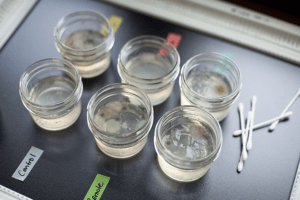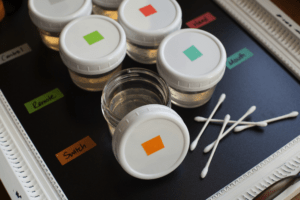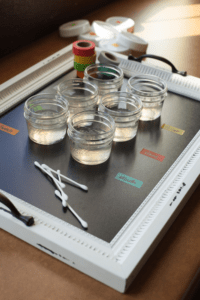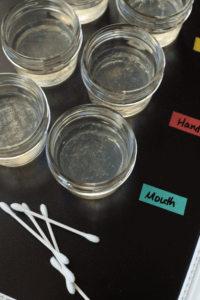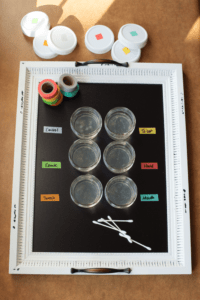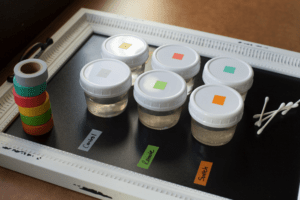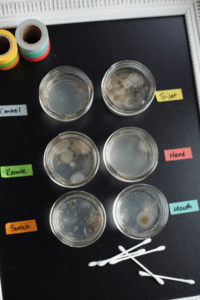Germs, Germs, Germs
When you touch something nasty, you can wash your hands with soapy water to get the germs off. Many children around the world can’t do that because they don’t have running water inside their homes. Germs can make them very sick. They can make us sick, too. That’s why it’s so important to wash our hands. Conduct this experiment to see how many germs lurk in your house. Which area do you think is the most germy?
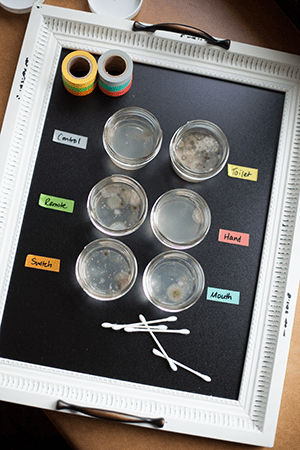
Supplies
Adult help needed.
- medium-size saucepan
- 1 c. water
- 1 beef bouillon cube or 1 tsp. bouillon granules
- 1½ packages Knox unflavored gelatin
- 2 tsp. sugar
- 3-5 clear plastic containers with lids or foil muffin tins and plastic wrap
- cotton swabs
- 1-gallon plastic bags
- liquid bleach
- piece of paper to write down your observations, or download our experiment worksheets here.

Step 1
Ask a question.
How germy is my home, my pet and my body?

Step 2
Do background research.
- Do a Google search for the types of germs found in most houses.
- Do a Google search for petri dishes.
- Draw pictures of what you think germs look like.

Step 3
Construct a hypothesis.
A hypothesis is just your best guess as to what you think will happen in your experiment. So, using the information from your research, your hypothesis might look like this: “I think the toilet handle will have the most germs in the house.”
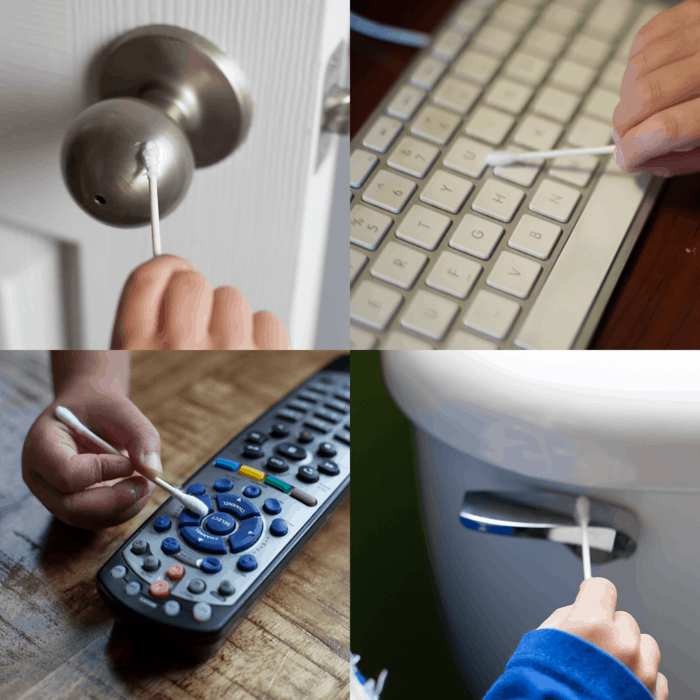
Step 4
Test with experimentation.
- Make agar (with an adult's help):
- Remove the saucepan from the stove, cover it, and let the agar mixture cool for 15 minutes.
- Place the lids loosely on top of the containers or cover the foil muffin tins loosely with plastic wrap and place them in the refrigerator to set. The containers will be ready for use when the agar is the solid consistency of Jell-O. These are your petri dishes!
- Take cotton swabs and run them over places you think germs might live. Some ideas include:
- the flush handle on the toilet
- doorknobs
- computer keyboards
- TV remote control
- kitchen counter
- inside your pet’s mouth
- inside your mouth
- After you use a swab, rub it immediately on top of the agar in the dish labeled with that specific place (for example, "doorknob.") Place the lid or plastic wrap back on the container.
- Once all the petri dishes have been swabbed and covered, place them in a warm location such as a sunny windowsill.
- Check them daily to see if the germs have multiplied (you may want to take pictures to record the growth).
- Record these findings on the observation sheet.

Step 5
Is your procedure working?
You might have to move the dishes to a warmer spot if you don't notice any changes.

Step 6
Analyze the data and draw conclusions.
This is where you figure out if the results of your experiment match your hypothesis — or best guess — or if part or none of the results matched your hypothesis. For example, did the toilet flush handle have the most germs, or was it your television remote?

Step 7
Communicate your results.
Share your observation sheet and the results of your experiment with your family.

Step 8
Safely dispose!
It is important to throw away the petri dishes safely. Have an adult put a thin layer of bleach on top of the agar where the germs grew. Put the lids on tightly and place the containers in a plastic bag. Make sure the plastic bag is sealed, and throw it into your outside garbage can the night before collection.
Supplies

Adult help needed.
- medium-size saucepan
- 1 c. water
- 1 beef bouillon cube or 1 tsp. bouillon granules
- 1½ packages Knox unflavored gelatin
- 2 tsp. sugar
- 3-5 clear plastic containers with lids or foil muffin tins and plastic wrap
- cotton swabs
- 1-gallon plastic bags
- liquid bleach
- piece of paper to write down your observations, or download our experiment worksheets here.
Step 1

Ask a question.
How germy is my home, my pet and my body?
Step 2

Do background research.
- Do a Google search for the types of germs found in most houses.
- Do a Google search for petri dishes.
- Draw pictures of what you think germs look like.
Step 3

Construct a hypothesis.
A hypothesis is just your best guess as to what you think will happen in your experiment. So, using the information from your research, your hypothesis might look like this: “I think the toilet handle will have the most germs in the house.”
Step 4

Test with experimentation.
- Make agar (with an adult's help):
- Remove the saucepan from the stove, cover it, and let the agar mixture cool for 15 minutes.
- Place the lids loosely on top of the containers or cover the foil muffin tins loosely with plastic wrap and place them in the refrigerator to set. The containers will be ready for use when the agar is the solid consistency of Jell-O. These are your petri dishes!
- Take cotton swabs and run them over places you think germs might live. Some ideas include:
- the flush handle on the toilet
- doorknobs
- computer keyboards
- TV remote control
- kitchen counter
- inside your pet’s mouth
- inside your mouth
- After you use a swab, rub it immediately on top of the agar in the dish labeled with that specific place (for example, "doorknob.") Place the lid or plastic wrap back on the container.
- Once all the petri dishes have been swabbed and covered, place them in a warm location such as a sunny windowsill.
- Check them daily to see if the germs have multiplied (you may want to take pictures to record the growth).
- Record these findings on the observation sheet.
Step 5

Is your procedure working?
You might have to move the dishes to a warmer spot if you don't notice any changes.
Step 6

Analyze the data and draw conclusions.
This is where you figure out if the results of your experiment match your hypothesis — or best guess — or if part or none of the results matched your hypothesis. For example, did the toilet flush handle have the most germs, or was it your television remote?
Step 7

Communicate your results.
Share your observation sheet and the results of your experiment with your family.
Step 8

Safely dispose!
It is important to throw away the petri dishes safely. Have an adult put a thin layer of bleach on top of the agar where the germs grew. Put the lids on tightly and place the containers in a plastic bag. Make sure the plastic bag is sealed, and throw it into your outside garbage can the night before collection.


